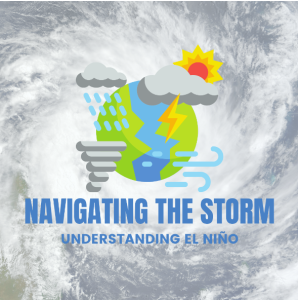Navigating the Storm: Understanding El Niño’s Role in Midwest Weather
By Bianca Loglisci, C2ST Intern, Loyola University
If you live in the Midwest, you may have noticed that the weather has been all over the place lately. From 70-degree days in mid-February to 20-degree days at the end of March, the fluctuating seasons may seem frustratingly unexplainable. Part of an explanation for this wacky weather falls to a natural phenomenon called El Niño.

El Niño happens when trade winds that naturally blow from east to west due to the earth’s rotation begin to weaken. This causes warm water, which normally rests in the Indian and Pacific oceans, to push eastward and pile up near the equator. When this happens, the warm water heats the air above it. As the warm air moves, it changes the way weather patterns occur around the globe. Weather trends during El Niño vary by specific location, but in general, temperatures and precipitation tend to increase. El Niño also has an alter ego called La Niña, El Nino’s chilly counterpart. Trade winds grow stronger, causing colder ocean waters near the equator and overall colder temperatures and less precipitation.
El Niño and La Niña usually begin in the fall when ocean temperatures begin to shift below or above normal; these shifts can last anywhere from 9 to 12 months. The weather effects are usually strongest in the winter months of December through March. There can also be neutral years (with no El Niño or La Niña) where trade winds, ocean temperatures, and weather patterns are generally normal.
This year is an El Niño year. Back in October of 2023 at the start of the cycle, the El Niño conditions were predicted to last until at least April. The Midwest tends to get warmer and drier than usual during El Niño, meaning higher average temperatures and less rain and snow. Sure enough, aside from the singular week in January in which temperatures fell below zero, winter in the Midwest this year has barely felt like winter. Several cities in the Midwest received much less snow than normal and experienced one of the warmest winters on record.
Because El Niño and La Niña vary so much in intensity from year to year, it is difficult for scientists to understand how their effects will change in the future. However, many scientists believe that human-induced climate change may be causing stronger El Niños, and the effects of El Niño may also be worsened by climate change. Unless climate change can be combated, we may want to start getting used to warmer and drier winters here in the Midwest.
References
- https://www.youtube.com/watch?v=wVlfyhs64IY
- https://theconversation.com/what-is-a-strong-el-nino-meteorologists-anticipate-a-big-impact-in-winter-2023-2024-but-the-forecasts-dont-all-agree-215395
- https://wmo.int/news/media-centre/el-nino-expected-last-least-until-april-2024
- https://www.cnn.com/2024/02/11/weather/midwest-non-winter-el-nino/index.html
- https://www.imperial.ac.uk/grantham/publications/climate-change-faqs/what-is-el-nino/